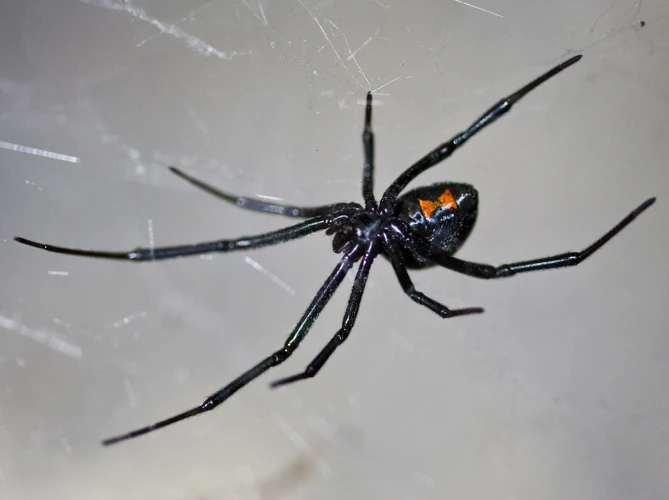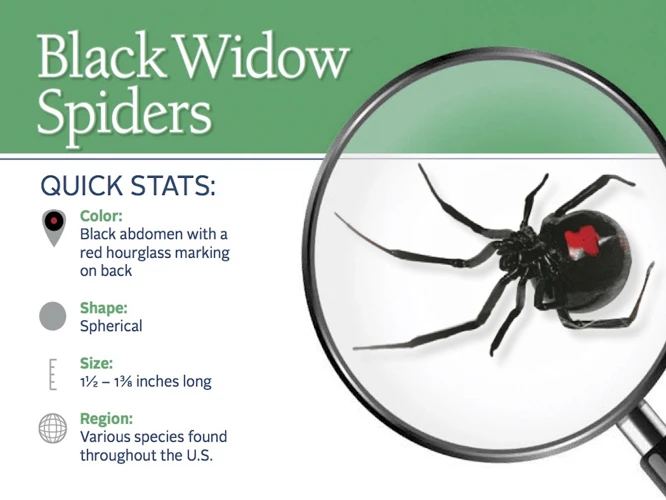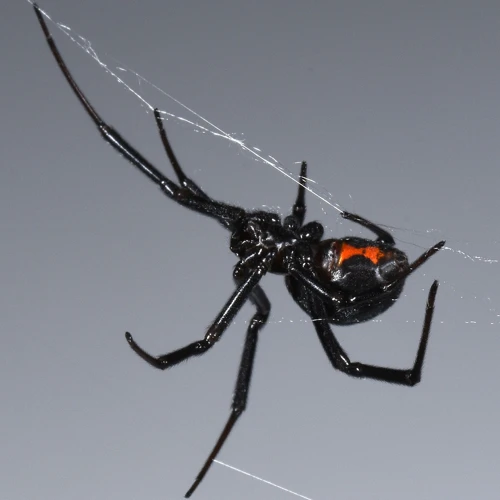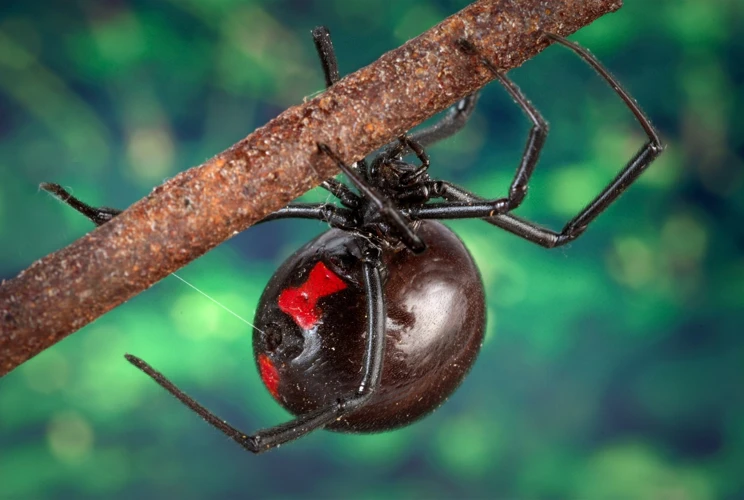Introduction

The Black Widow spider is a well-known arachnid that evokes fear and intrigue in people all over the world. While some may say that they are beautiful creatures with their hourglass-shaped markings, they are also highly venomous and can pose a significant threat to humans. In this article, we will explore the natural habitat of black widow spiders and how their surroundings affect their venom potency and bite susceptibility. We will also provide tips for avoiding their bites and outline the proper treatment for those unfortunate enough to fall victim to one. So, let’s dive into the mysterious world of the Black Widow spider.
What are Black Widow Spiders?
Black Widow spiders are a type of spider that is known for its unique appearance and venomous bite, which can be dangerous to humans. They are part of the Latrodectus genus, which includes over 30 different species of widow spiders. [1]
The female Black Widow spider is easy to identify due to its shiny black color and distinctive red hourglass marking on the underside of its abdomen. The males, on the other hand, are about half the size of the females and have a less prominent marking (usually yellow, white, or red) on their abdomens. [2]
Black Widow spiders are found throughout the world, but most commonly in warmer regions, such as the southern and western US, South America, Africa, and southern Europe. They prefer dark, dry, and sheltered areas, such as garages, storage sheds, and crawl spaces. [3]
Despite their reputation as a dangerous spider, Black Widows generally only bite humans when they feel threatened or cornered. Their venom is a neurotoxin and affects the nervous system, which can cause muscle cramps, spasms, and other unpleasant symptoms. [4]
Their Natural Habitat: Where are They Found?
Black Widow spiders are found in different parts of the world, although they are most commonly found in North and South America. These spiders are known for their glossy, jet-black color and the distinctive red hourglass-shaped mark on their abdomen. Black Widow spiders can typically be found in dark, secluded areas where they can hide from predators and wait for prey to come to them.
Here are some specific areas where black widow spiders may be found:
- In outdoor environments, black widow spiders may be found in woodpiles, sheds, garages, and other outdoor structures that provide cover.
- Indoors, black widow spiders may be found in undisturbed areas such as basements, closets, or crawl spaces.
- They can also be found in areas with a lot of clutter or debris where they can easily hide.
- If there are rodents or insects around, black widow spiders may be attracted to these areas, as they are a food source for the spiders.
It’s important to note that while black widow spiders can be found in many different environments, they are not typically found in areas with extreme heat or cold. They prefer environments that are warm and humid, which is why they are commonly found in southern states in the United States.
If you live in an area where black widow spiders are common, it’s important to take precautions to protect yourself and your family. By understanding their natural habitat, you can take steps to avoid encountering them. For more information about the effects of their habitat on black widow spiders, see the next section.
Effects of Habitat on Black Widow Spiders

Understanding how the natural habitat affects black widow spiders can be crucial in identifying their potential danger to humans and animals. The environment in which black widow spiders live can greatly impact their behavior, biology, and physiology. Factors such as climate, nesting habits, and food availability can all influence the life cycle of black widow spiders. With this in mind, we’ll dive deeper into the effects of habitat on black widow spiders. But first, let’s remember the importance of identifying the potency of black widow venom and the susceptibility to their bites. For more information on black widow venom, click here.
Climate and Temperature
Climate and temperature play a crucial role in determining the natural habitat of black widow spiders. These spiders prefer living in warm and dry climates. They are commonly found in the southeastern United States, particularly in states such as Florida and Georgia. Black widow spiders also inhabit other regions of North America, including California, Arizona, and New Mexico, as well as parts of South America.
Hot and arid environments are perfect for black widows to thrive in as they prefer lower humidity levels. In such environments, black widow spiders can be found in a variety of locations, including outdoor structures such as sheds and barns, as well as inside homes, particularly in basements and attics. They may also build nests in woodpiles, shrubs, and bushes, making it essential to check these areas when spending time outdoors.
On the other hand, black widow spiders are not well adapted to colder temperatures and cannot survive in freezing environments. During the winter months, these spiders may seek refuge indoors, increasing the risk of human encounters.
Climate and temperature can also affect the venom potency of black widow spiders. According to studies, heat causes the venom of black widow spiders to become more potent, resulting in more severe symptoms and reactions when an individual is bitten. As such, individuals living in areas with warm climates should be extra cautious when spending time outdoors and learn to identify the signs and symptoms of a black widow spider bite.
Black widow spider venom affects various systems in the human body. Proper understanding of these effects can help individuals take necessary precautions to avoid potential bites from these spiders.
Nesting Habits and Materials Used
Nesting Habits and Materials Used by Black Widow Spiders
Black Widow spiders are notorious for building sticky, tangled webs in dark, undisturbed areas. The webs are used by the spiders for catching prey as well as a place for them to live. These spiders prefer to build their nests outdoors and indoors in areas that are undisturbed.
The webs of Black Widow spiders are typically constructed in corners, crevices, and dark areas of the home or outdoor structures such as sheds, garages, and barns. They are also found in areas under rocks, logs, and other debris.
The nesting materials used by Black Widow spiders include silk produced by their bodies. The silk is an important material in creating their sticky webs as well as creating their egg sacs. The egg sacs are white or cream in color and are spherical or slightly oval-shaped.
Black Widow spiders produce dozens of eggs that can stay intact for several weeks. The female spider usually guards the eggs tirelessly with her life. Once the eggs hatch, spiderlings will emerge and disperse from the nest as they are ready for a life on their own.
Here is a table summarizing the nesting habits and materials used by Black Widow Spiders:
| Aspect | Description |
|---|---|
| Nesting Location | Undisturbed areas such as corners, crevices, and dark areas of the home or outdoor structures like sheds, garages, and barns; areas under rocks, logs, and other debris |
| Nesting Materials | Silk produced by their bodies used in creating sticky webs and egg sacs |
| Egg Sac | White or cream-colored, spherical or slightly oval-shaped which can hold dozens of eggs |
If you suspect that you have a Black Widow spider nest in your home or outdoor area, it is important to contact a professional pest control service for removal. It is highly recommended that individuals do not attempt to remove the nest themselves as it can be dangerous and lead to bites, which can be serious or even fatal.
Food Availability and Diet
Black Widow Spiders’ diet plays a pivotal role in their survival and health. They are carnivores who feed primarily on insects, but when necessary, they are capable of consuming small frogs and reptiles as well. The availability of food in their natural habitat dictates their growth and development. For instance, if there is a shortage of food, they might end up eating each other in order to meet their nutrient needs. However, if an abundance of food is present, they will grow and develop to their full potential.
Studies show that black widow spiders are more active at night and prefer to hunt during that time. They use their webs to trap their prey, which is then immobilized by venom. Black widows have a unique feeding habit as they consume just enough of their prey to meet their nutrient requirements and store the rest for future needs.
Their venom also plays a significant role in their feeding patterns. Black Widow Spider venom is more potent than most spiders, containing several neurotoxins that affect the human nervous system. The potency of the venom has evolved over time to allow the spiders to effectively immobilize their prey, enabling them to feed without risk of injury. As a consequence, black widow spiders can consume their prey more easily, with less struggle.
The diet of black widow spiders plays an imperative role in their existence and behavior. The availability of food in their natural habitat affects their growth and development. Their venom has evolved to meet their predatory needs, allowing them to efficiently consume their prey. The information provides valuable insights into the black widow spider’s natural habitat and their survival strategies.
Understanding the components of Black Widow Spider venom, and how they can affect the human body, is critical for understanding how the spiders’ predatory habits function.
Connection between Venom Potency and Bite Susceptibility

It’s important to understand the connection between venom potency and bite susceptibility when it comes to black widow spiders. These spiders are known for their venom, which can be harmful to humans. The potency of the venom can vary depending on different factors such as the age and size of the spider, as well as environmental factors. Understanding the potential effects of the venom and how susceptible an individual may be to a black widow spider bite can help determine the appropriate course of action if a bite occurs. In this section, we’ll delve into the factors that affect venom potency and how to identify one’s bite susceptibility.
Factors Affecting Venom Potency
The potency of Black Widow Spider venom can vary depending on a number of factors, such as the age and gender of the spider, as well as its environment and diet. Here are some of the key factors that affect the potency of Black Widow Spider venom:
| Factor | Description |
|---|---|
| Age and Gender of the Spider | The venom of female Black Widow Spiders is generally more potent than that of males. Similarly, adult spiders produce more potent venom than juveniles. |
| Diet | The potency of spider venom is largely determined by the composition of their diet. Spiders that feed on a variety of prey tend to produce more potent venom than those with a limited diet. |
| Environment | Black Widow Spiders living in harsh or stressful environments may produce more potent venom as a way of increasing their chances of survival. |
| Evolutionary History | Black Widow Spiders have evolved their venom over millions of years in response to changing ecological pressures, resulting in potent and complex cocktails of toxins. |
Understanding these factors is important for assessing the potential danger of a Black Widow Spider bite. If you suspect that you have been bitten by a Black Widow Spider, it is important to seek medical attention as soon as possible. For information on identifying the symptoms of a Black Widow Spider bite, please see our article on Black Widow Spider Symptoms. For more information on the long-term effects of Black Widow Spider venom, please see our article on Black Widow Spider Venom Long-term Effects.
Identifying a Black Widow Spider’s Bite Susceptibility
It’s important to be able to identify a black widow spider’s bite susceptibility, especially if you’re spending time in an area where they are common. Here are some things to look out for:
- Symptoms: A bite from a black widow spider can cause a variety of symptoms, including severe pain and muscle cramping, nausea and vomiting, sweating, and difficulty breathing. If you experience these symptoms, seek medical attention immediately.
- Location: Black widow spider bites usually occur on the extremities, such as the hands, feet, or ankles. If you notice a bite in one of these areas, it’s important to check for other signs of a black widow spider infestation, such as webs or spiders themselves.
- Bite marks: The bite itself may have two distinct puncture marks, which are often surrounded by redness or swelling. If you see these marks and experience any of the symptoms described above, it’s best to assume that you’ve been bitten by a black widow spider.
If you suspect that you’ve been bitten by a black widow spider, it’s important to seek medical attention immediately. The venom from a black widow spider can be especially potent and should be treated as soon as possible. By clicking on this link, you can access more information on what to do if you think you’ve been bitten by a black widow spider.
Prevention and Treatment
When it comes to preventing and treating black widow spider bites, there are some important steps you should take. Prevention is the first line of defense against these venomous spiders. By taking the necessary precautions, you can minimize your exposure to black widows and reduce your chances of being bitten. Treatment, on the other hand, requires prompt action to alleviate the symptoms of a bite and avoid complications. Let’s explore some tips for avoiding black widow spider bites and what to do if you are bitten.
Tips for Avoiding Black Widow Spider Bites
Black Widow Spiders are one of the most feared species of spiders due to their highly venomous nature. If you live in an area where Black Widow Spiders are prevalent, it’s important to take some precautions to avoid their bites. Here are some tips for avoiding Black Widow Spider bites:
- Wear protective clothing: When working or spending time in areas where Black Widow Spiders live, wear long-sleeved shirts, long pants, and gloves to protect your skin.
- Check for spider presence before moving items: Be sure to look for signs of a black widow spider before moving items that have been sitting for a long period of time and are likely to have spiders around, such as garden gloves, outdoor furniture, or firewood.
- Keep your home clean: Spiders love clutter, so keeping your home uncluttered can help prevent the appearance of spiders. Additionally, regularly dusting and vacuuming your home can help get rid of spiders.
- Seal cracks and crevices: Check your doors and windows to make sure there are no gaps or holes for spiders to enter your home through. Seal up any gaps or openings around piping, wiring or any other points of entry to prevent spiders from sneaking in.
- Use insecticides: If you discover black widow spiders near your home, you can use insecticides to kill them. However, be sure to follow the instructions on the label carefully to avoid any harmful effects on people or pets.
By following these tips, you can greatly reduce the chances of a Black Widow Spider bite. However, if you do experience a bite, it’s important to seek medical attention immediately. For more information on the effects of Black Widow Spider venom, you can read our article on Black Widow Spider Venom Effects.
Treatment for Black Widow Spider Bites
If you suspect that you have been bitten by a black widow spider, it’s important to seek medical attention immediately. Black widow spider bites can be deadly without proper medical treatment. Here are some treatments that may be administered for black widow spider bites:
- Antivenom: Antivenom is the most effective treatment for severe black widow spider bites. It is administered in a hospital setting and can help neutralize the venom in the body. The antivenom is made by injecting small amounts of black widow venom into horses, which develop an immunity to the toxin. The horse’s blood is then harvested and processed into antivenom.
- Pain Management: Over-the-counter pain medications such as ibuprofen or acetaminophen can help alleviate pain caused by a black widow spider bite. In some cases, the doctor may prescribe stronger pain medication or apply a numbing agent to the bite area.
- Wound care: The bite wound may need to be cleaned and dressed with an antibiotic ointment or cream to prevent infection. It’s important to keep the wound clean and dry.
It’s important to note that home remedies such as applying heat, incision, or sucking out the venom are not recommended. These remedies can make the situation worse and may cause additional harm or infection.
Remember, black widow spider bites can be serious and sometimes deadly. Seek medical attention as soon as possible if you suspect you have been bitten by a black widow spider. To learn more about black widow spider venom and its effects on the nervous system, read our article on black widow venom and the nervous system.
Conclusion
Black widow spiders are fascinating creatures that have been gaining more attention recently due to the potency of their venom and the harm they can cause. Through this article, we have learned about the natural habitat of these spiders and how it affects their venom potency and bite susceptibility.
It is important to note that while black widow spiders can be dangerous, they are also an important part of the ecosystem and play a role in controlling pest populations. Educating oneself on the proper precautions to take when encountering these spiders can greatly reduce the risk of being bitten.
Overall, the topic of black widow spiders is a vast one with many different areas to explore. From the history and evolution of their venom to the impact of climate and diet on their behavior, there is much to learn. By continuing to study and research these creatures, we can further our understanding of their role in the ecosystem and ways to coexist safely.
Frequently Asked Questions
What should I do if I see a Black Widow spider in my home?
If you spot a Black Widow spider in your home, it’s best to eliminate the spider or to contact pest control in moderate and severe cases.
What types of environments do Black Widow spiders thrive in?
Black Widow spiders thrive in warm and dry environments, including deserts, shrublands, and forests.
Are Black Widow spiders aggressive towards humans?
Black Widow spiders typically avoid humans and only bite in self-defense when they feel threatened.
What should I do if I am bitten by a Black Widow spider?
If you’re bitten by a Black Widow spider, it’s essential to seek medical attention immediately.
Are there any natural predators of Black Widow spiders?
Birds, lizards, and some other spiders prey on Black Widow spiders in their natural habitats.
How can I identify a Black Widow spider?
Black Widow spiders have a distinctive black body and red hourglass-shaped marking on their abdomen. They also have eight legs and round, bulbous abdomens.
Do all Black Widow spiders have the same level of venom potency?
No, the venom potency of Black Widow spiders varies depending on various factors like age, size, and diet.
Can Black Widow spider bites be fatal?
Although rare, Black Widow spider bites can be fatal. However, with proper medical care, most bites are not life-threatening.
How can I prevent Black Widow spider infestations in my home?
To prevent Black Widow spider infestations, seal up any cracks or crevices in your home, keep clutter to a minimum, and remove any webs you see immediately.
What is the best way to treat a Black Widow spider bite?
Treatment for Black Widow spider bites involves taking painkillers, cleaning the bite area, and seeking medical attention to manage symptoms and prevent complications if necessary.






